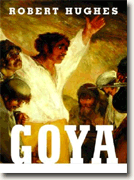Robert Hughes/Evan S. Connell
book reviews:
· general fiction
· chick lit/romance
· sci-fi/fantasy
· graphic novels
· nonfiction
· audio books
· author interviews
· children's books @
curledupkids.com
· DVD reviews @
curledupdvd.com
newsletter
win books
buy online
links
home
for authors
& publishers
for reviewers

 |
Robert Hughes/Evan S. Connell Knopf/Counterpoint Hardcover/Hardcover 429 pages/272 pages November 2003/January 2004 |
|
There is presently no excuse for ignorance on the subject of Goya, thanks to two lately-published, complementary biographies by a couple of real polymaths. In a glossily illustrated, exhaustive volume, Robert Hughes approaches Spain’s foremost portraitist with the-man-is-his-work strategy and analyzes the bulk of Goya’s fifty-year output while comprehensively mining a politically troubled Spain. This is a cogent presentation, in near-faithful sequence, of nearly everything Goya (and seemingly everything Spanish monarchy), and Hughes clearly intends to refute the artist’s legendary contempt for his royal employers—which is most notably suggested by the imperial portrait, The Family of Carlos IV. Preceding critics have credibly suggested that this commissioned work is a nose-thumbing caricature of some really unattractive Bourbon royals. But in his academically founded book, Hughes denies this impolitic attitude as too improbable for the savvy and ambitious painter: “The idea that [Goya] had set out to satirize the patrons he depended on,” writes Hughes, “dies hard, but it is of course the merest nonsense.”
Indeed, the appeal of reading both biographies is to enjoy the point-counterpoint of two fine authors on the acknowledged father of modern art. Each writer undeniably grasps the importance of context. But for Hughes, the art is paramount. A highlight is his prolonged, thoughtful embrace of Goya’s brilliant, “fiercely moralizing” lithographs: the Caprichos, a biting social satire of (mostly) women; and the Desastres de la Guerra, a journalistic exposé of combat horrors. A seasoned art critic for Time magazine, Hughes is also the connoisseur of painterly technique. Goya’s portrait of the Duchess Osuna, Spain’s premier noblewoman, is “one of the finest of his career,” Hughes claims, with “subtle gradations of color, translucent glazes overlaid with delicate passages of impasto.” By distinction, Connell is the aficionado of historical scuttlebutt and artistic motive. To wit, he concludes that the misogyny of the Caprichos is Goya’s bitter response to being dumped by a well-known socialite. And of Hughes’s beloved portrait of the Duchess Osuna, Connell describes the gown of this “unlovely woman” as “French blue, styled a l’Anglaise, bodice fastened in front, huge pink bow at the waist. Her flat hips are padded, the artificial curve emphasized with ribbons and roses.” Like a red-carpet gossip, Connell targets the Duchess’s fashion; while Hughes, the rendering of it. But these authors are not always at some manner of odds. Hughes is not a complete lapdog; and Connell, not a total snipe. For instance, Hughes recognizes Goya’s odd limitation to render convincing horses (or at least those outside of the bullring). The equestrian portrait of General Palafox indicates that Goya “was an able but by no means an exceptional horse painter,” or so Hughes equivocates. But Hughes also praises the “ghostly white, black shaded pinheaded nag” for its “immense energy,” and evocation of “one of the devilish, rawboned mounts of the Four Horsemen of the Apocalypse.” Connell retorts that the same animal is “a charger stolen from a carousel” and reflects, “How curious that an artist who…delineated some of the most expressive hands since Rembrandt—how strange that he would have trouble painting horses.” Connell is the evident quipster of the two, although Hughes also writes with a fashionable smartness. For the newcomer to Spanish art, Hughes’s scholarly volume is virtually mandatory; it is the latest bible on the subject. Connell’s book—while much more than a tabloid-style afterthought—is nevertheless the noncompulsory work; it is, comparatively, an amusing tip of the hat to Hughes’s formal homage. © 2004 by Barbara Martin for Curled Up With a Good Book |
|
|
|
 Click here to learn more about this month's sponsor! |
|
| fiction · sf/f · comic books · nonfiction · audio newsletter · free book contest · buy books online review index · links · · authors & publishers reviewers |
|
| site by ELBO Computing Resources, Inc. | |
 Novelist and historian Evan S. Connell is not so sure. With an erudite, gossipy charm, Connell also analyzes Goya’s character vis-à-vis Spain’s rich and connected, but with a pithy ambivalence that contrasts directly with Hughes’s extended tribute. On the many verdicts on the Carlos family portrait specifically, Connell first acknowledges the importance of the viewer’s era. But in a-wink-and-a-smile fashion, he then defines the portrayal of the royal family, including that of the famously slutty queen, María Luisa: “Goya shows us the raddled features of a dissolute harridan who could never have been attractive.”
Novelist and historian Evan S. Connell is not so sure. With an erudite, gossipy charm, Connell also analyzes Goya’s character vis-à-vis Spain’s rich and connected, but with a pithy ambivalence that contrasts directly with Hughes’s extended tribute. On the many verdicts on the Carlos family portrait specifically, Connell first acknowledges the importance of the viewer’s era. But in a-wink-and-a-smile fashion, he then defines the portrayal of the royal family, including that of the famously slutty queen, María Luisa: “Goya shows us the raddled features of a dissolute harridan who could never have been attractive.”